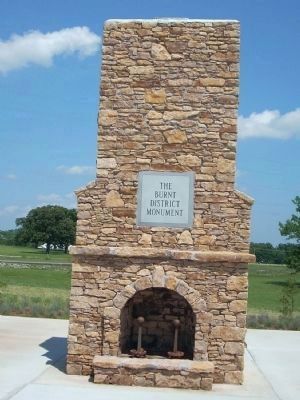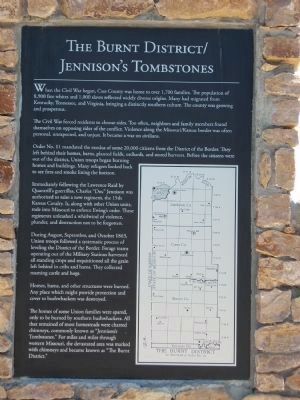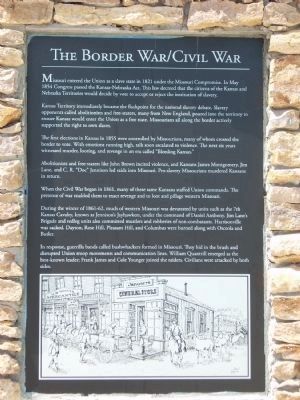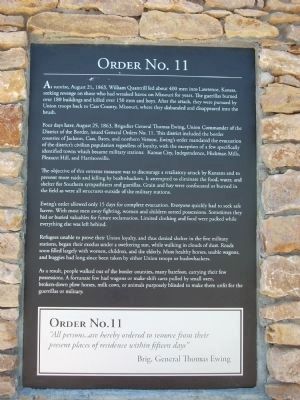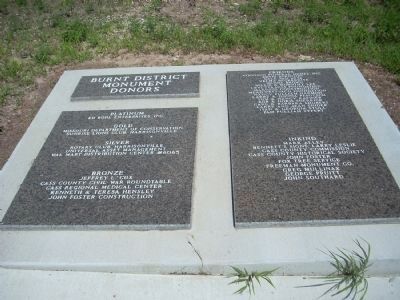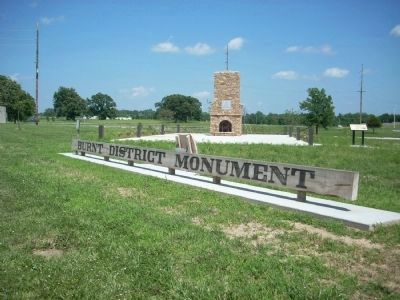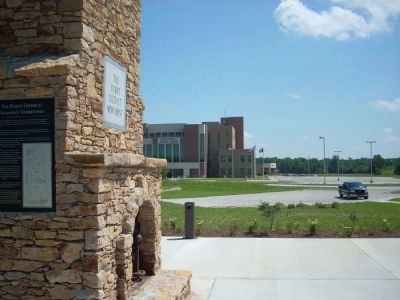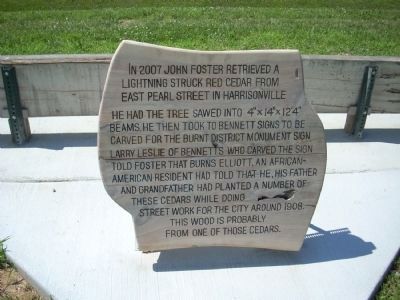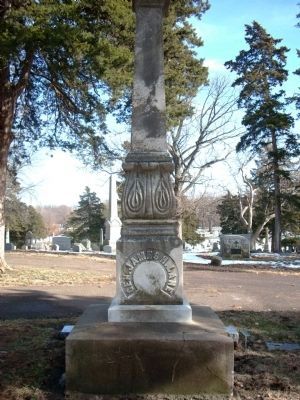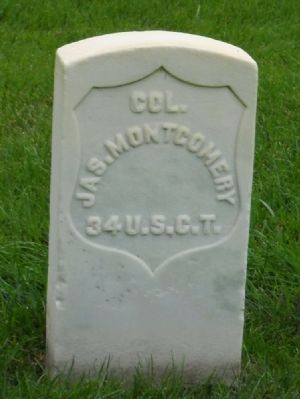Harrisonville in Cass County, Missouri — The American Midwest (Upper Plains)
The Burnt District Monument
When the Civil War began, Cass County was home to over 1,700 families. The population of 8,900 free whites and 1,000 slaves reflected widely diverse origins. Many had migrated from Kentucky, Tennessee,and Virginia, bringing a distinctly southern culture. The county was growing and prosperous.
The Civil War forced residents to choose sides. Too often, neighbors and family members found themselves on opposing sides of the conflict. Violence along the Missouri/Kansas border was often personal, unexpected, and unjust. It became a war on civilians.
Order No. 11 mandated the exodus of some 20,000 citizens from the District of the Border. They left behind their homes, barns, planted fields, orchards, and stored harvests. Before the citizens were out of the district, Union troops began burning homes and buildings. Many refugees looked back to see fires and smoke lining the horizon.
Immediately following the Lawrence Raid by Quantrill's guerrillas, Charles "Doc" Jennison was authorized to raise a new regiment, the 15th Kansas Cavalry. It, along with other Union units, rode into Missouri to enforce Ewing's order. These regiments unleashed a whirlwind of violence, plunder, and destruction not to be forgotten.
During August, September, and October 1863, Union troops followed a systematic process of leveling the District of the Border. Forage teams operating out of the Military Stations harvested all standing crops and requisitioned all the grain left behind in cribs and barns. They collected roaming cattle and hogs.
Homes, barns, and other structures were burned. Any place which might provide protection and cover to bushwackers was destroyed.
The homes of some Union families were spared, only to be burned by southern bushwackers. All that remained of most homesteads were charred chimneys, commonly known as "Jennison's Tombstones." For miles and miles through western Missouri, the devastated area was marked with chimneys and became known as "The Burnt District."
map of the Burnt District as described by Order No. 11
(Right Side Plaque)
Missouri entered the Union as a slave state in 1821 under the Missouri Compromise. In May 1854 Congress passed the Kansas-Nebraska Act. This law decreed that the citizens of the Kansas and Nebraska Territories would decide by vote to accept or reject the institution of slavery.
Kansas Territory immediately became the flashpoint for the national slavery debate. Slavery opponents called abolitionists and free-staters, many from New England, poured into the territory to ensure that Kansas would enter the Union as a free state. Missourians all along the border actively supported the right to own slaves.
The first elections in Kansas in 1855 were controlled by Missourians, many of whom crossed the border to vote. With emotions running high, talk soon escalated to violence. The next six years witnessed murder, looting, and revenge in an era called "Bleeding Kansas."
Abolitionist and free-staters like John Brown incited violence, and Kansans James Montgomery, Jim Lane, and C. R. "Doc" Jennison led raids into Missouri. Pro-slavery Missourians murdered Kansans in return.
When the Civil War began in 1861, many of these same Kansans staffed Union commands. The pretense of war enabled them to exact revenge and to loot and pillage western Missouri.
During the winter of 1861-62, much of western Missouri was devastated by units such as the 7th Kansas Cavalry, known as Jennison's Jayhawkers, under the command of Daniel Anthony. Jim Lane's Brigade and redleg units also committed murders and robberies of non-combatants. Harrisonville was sacked. Dayton, Rose Hill, Pleasant Hill, and Columbus were burned along with Osceola and Butler.
In response, guerrilla bands called bushwackers formed in Missouri. They hid in the brush and disrupted Union troop movements and communication lines. William Quantrill emerged as the best-known leader; Frank James and Cole Younger joined the raiders. Civilians were attacked by both sides.
Picture showing Union troops looting Harrisonville.
(Plaque on Back)
At sunrise, August 21, 1863, William Quantrill led about 400 men into Lawrence, Kansas, seeking revenge on those who had wreaked havoc on Missouri for years. The guerrillas burned over 180 buildings and killed over 150 men and boys. After the attack, they were pursued by Union troops back into Cass County, Missouri, where they disbanded and disappeared into the brush.
Four days later, August 25, 1863, Brigadier General Thomas Ewing, Union Commander of the District of the Border, issued General Orders No. 11. This district included the border counties of Jackson, Cass, Bates and northern Vernon. Ewing's order mandated the evacuation of the district's civilian population regardless of loyalty, with the exception of a few specifically identified towns which became military stations: Kansas City, Independence, Hickman Mills, Pleasant Hill, and Harrisonville.
The objective of this extreme measure was to discourage a retaliatory attack by Kansans and to prevent more raids and killings by bushwackers. It attempted to eliminate the food, water, and shelter for Southern sympathizers and guerrillas. Grain and hay were confiscated or burned in the field as were all structures outside the military stations.
Ewing's order allowed only 15 days for complete evacuation. Everyone quickly had to seek safe haven. With most men away fighting, women and children sorted possessions. Sometimes they hid or buried valuables for future reclamation. Limited clothing and food were packed while everything else was left behind.
Refugees unable to prove their Union loyalty, and thus denied shelter in the five military stations, began their exodus under a sweltering sun, while walking in clouds of dust. Roads were filled largely by women, children, and the elderly. Most healthy horses, usable wagons, and buggies had long since been taken by either Union troops or bushwackers.
As a result, people walked out of the border counties, many barefoot, carrying their few possessions. A fortunate few had wagons or make-shift carts pulled by small oxen, broken-down plow horses, milk cows, or animals blinded to make them unfit for the guerrillas or military.
Order No 11
"All persons ... are hereby ordered to remove from their present places of residence within 15 days" Brig. General Thomas Ewing
Erected 2009 by Cass County Historical Society.
Topics. This historical marker and monument is listed in these topic lists: Government & Politics • Military • Notable Events • Settlements & Settlers • War, US Civil. A significant historical month for this entry is May 1854.
Location. 38° 39.076′ N, 94° 22.138′ W. Marker is in Harrisonville, Missouri, in Cass County. Marker is on West Wall Street (Missouri Route 2) ¼ mile west of U.S. 71, on the left when traveling west. The Burnt District Monument is on the grounds of the Cass County Justice Center. It is just off Missouri Highway 2 as you come into the entrance of the Justice Center. Touch for map. Marker is at or near this postal address: 2501 West Wall Street, Harrisonville MO 64701, United States of America. Touch for directions.
Other nearby markers. At least 8 other markers are within 3 miles of this marker, measured as the crow flies. A different marker also named Burnt District Monument (here, next to this marker); Lest We Forget (approx. 0.9 miles away); Jennison’s Jayhawks raid Harrisonville Square (approx. 1.1 miles away); Harrisonville WWI Memorial (approx. 1.1 miles away); Cass County (approx. 1.1 miles away); United We Stand Divided We Fall
(approx. 1.1 miles away); General Order No. 11 (approx. 1.1 miles away); Wayside Rest (approx. 2.4 miles away). Touch for a list and map of all markers in Harrisonville.
More about this monument. The Monument is a chimney - which was usually all that was left after the rest of the house was burnt. There are 6 markers associated with this monument. The description of Cedar Sign, the donor list, an overview plaque on the Burnt District, and three plaques on the chimney itself. In the future, a commemorative brick walk is planned.
Also see . . . The Civil War in Missouri. (Submitted on June 29, 2009, by Thomas Onions of Olathe, Kansas.)
Additional keywords. Burnt District Bleeding Kansas
Credits. This page was last revised on January 1, 2024. It was originally submitted on June 28, 2009, by Thomas Onions of Olathe, Kansas. This page has been viewed 8,916 times since then and 262 times this year. Last updated on September 1, 2009, by Thomas Onions of Olathe, Kansas. It was the Marker of the Week August 23, 2009. Photos: 1. submitted on June 28, 2009, by Thomas Onions of Olathe, Kansas. 2, 3, 4. submitted on June 29, 2009, by Thomas Onions of Olathe, Kansas. 5, 6, 7. submitted on June 28, 2009, by Thomas Onions of Olathe, Kansas. 8. submitted on June 30, 2009, by Thomas Onions of Olathe, Kansas. 9, 10. submitted on September 1, 2009, by Thomas Onions of Olathe, Kansas. • Kevin W. was the editor who published this page.
